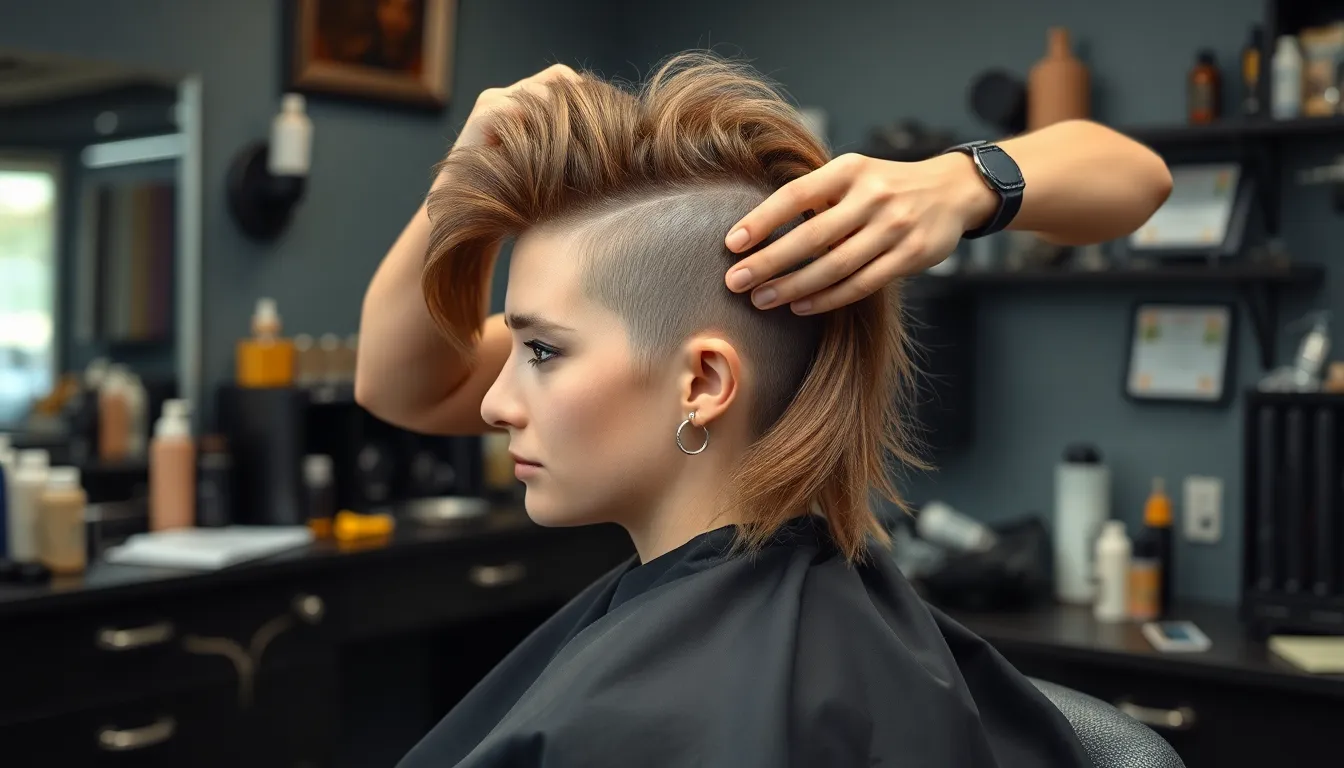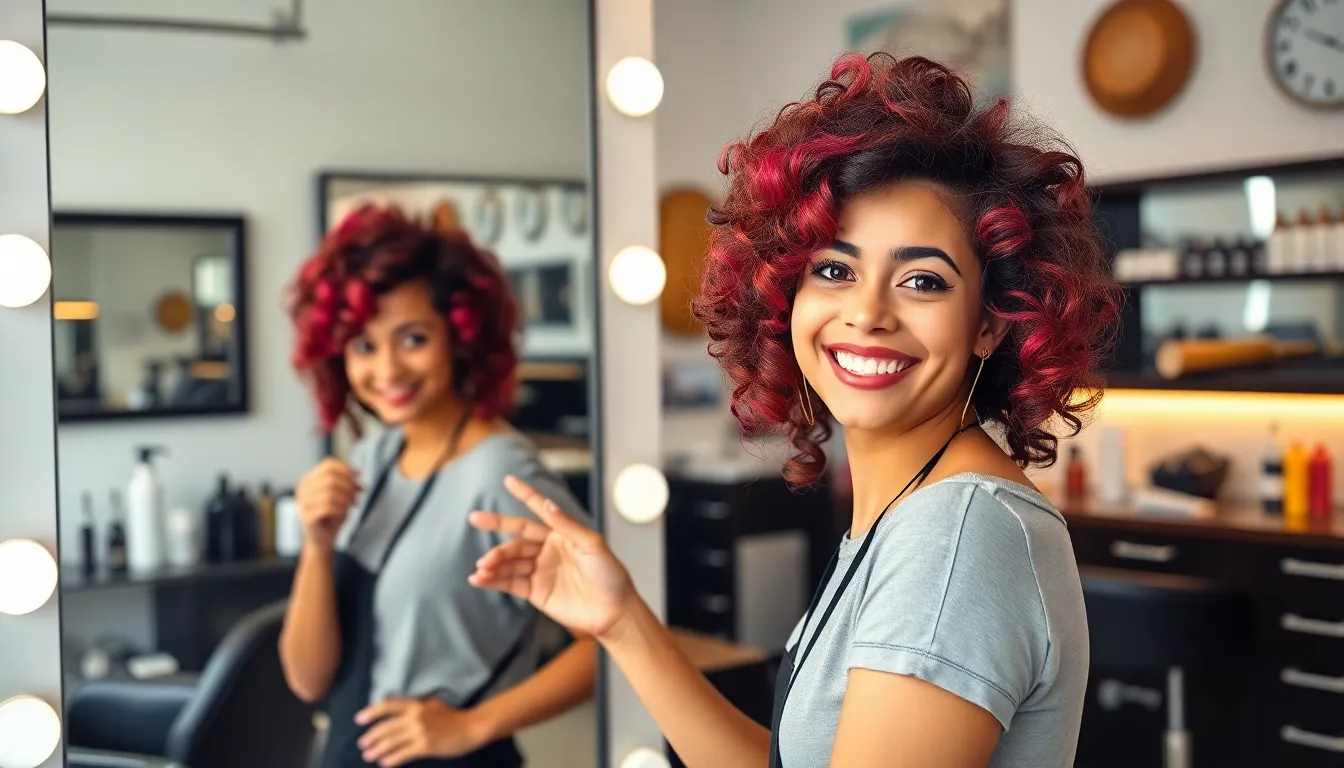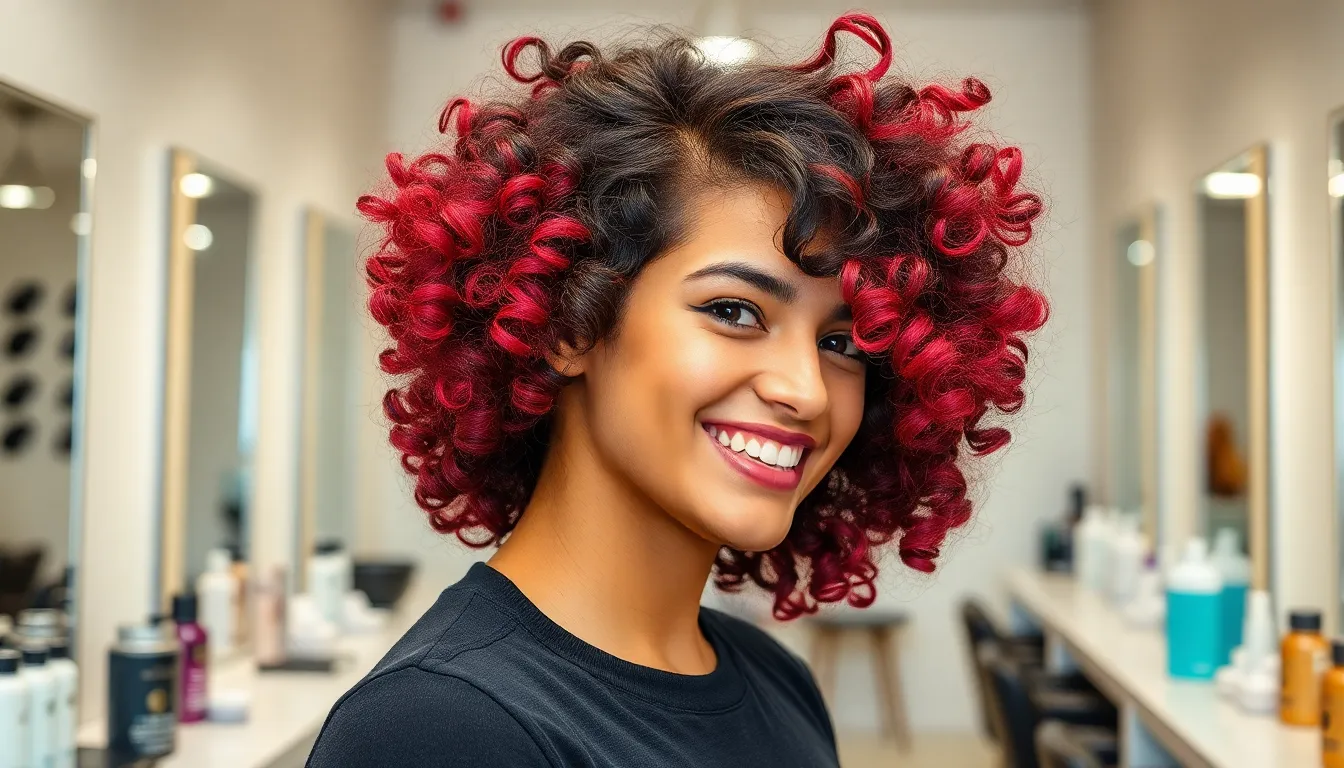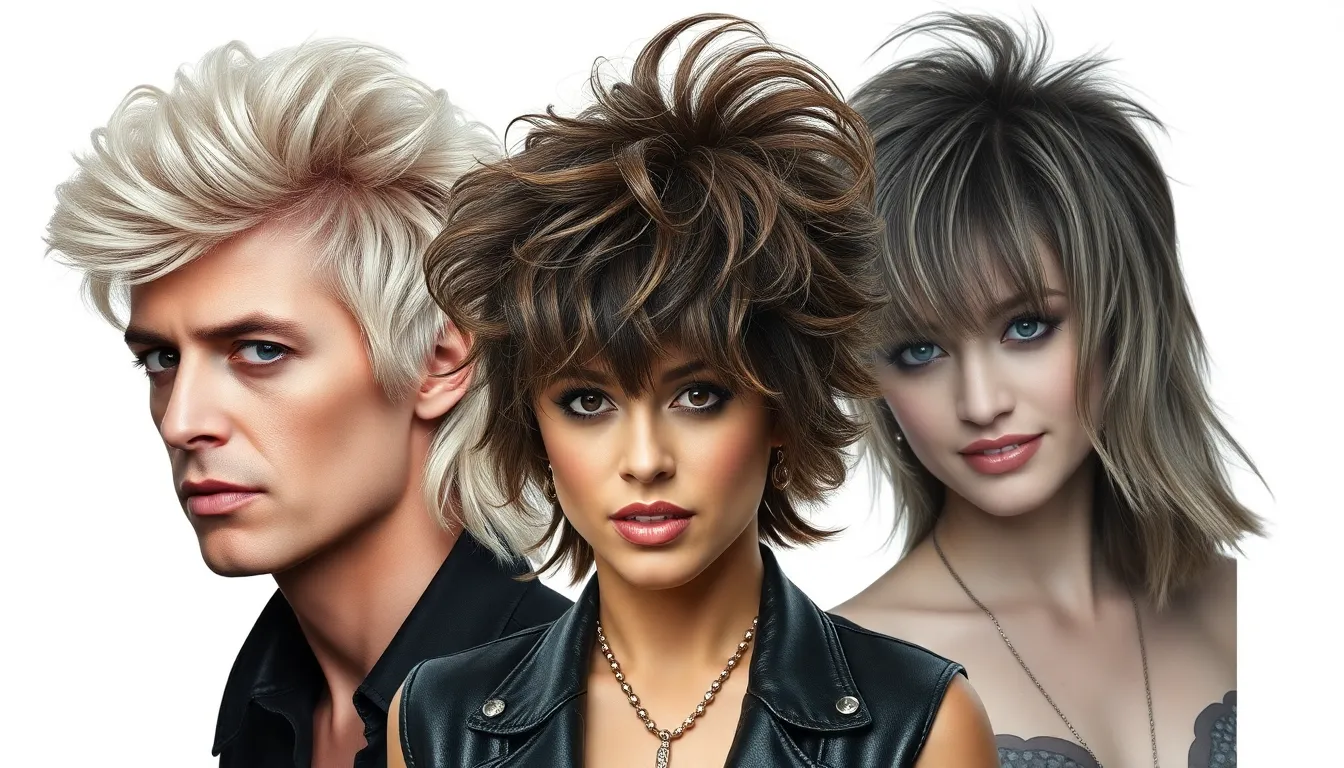The permed mullet is making a bold comeback and we’re absolutely here for it. This iconic hairstyle combines the edgy rebellion of a classic mullet with the voluminous texture of a perm – creating a look that’s both nostalgic and surprisingly modern. Whether you’re channeling ’80s rock star vibes or putting a fresh twist on retro style, the permed mullet delivers maximum impact with its “business in the front, party in the back” philosophy.
We’ve seen everyone from celebrities to everyday trendsetters embracing this daring cut, and it’s easy to understand why. The permed mullet isn’t just a hairstyle – it’s a statement piece that screams confidence and individuality. With the right styling techniques and proper maintenance, this look can work for various hair types and personal styles.
Ready to jump into the industry of permed mullets? We’ll guide you through everything you need to know about rocking this show-stopping style.
What Is a Permed Mullet and Why It’s Making a Comeback
This edgy hairstyle represents the perfect marriage between classic rebellion and textured volume. We’re witnessing a cultural shift that embraces bold self-expression through distinctive hair choices.
Definition of the Permed Mullet Hairstyle
Permed mullets combine the iconic “business in front, party in back” philosophy with chemically enhanced curls or waves throughout the entire style. We recognize this look by its shorter, manageable front sections paired with dramatically longer, voluminous back portions. The perm treatment adds crucial texture and body to both sections, creating a more ever-changing silhouette than traditional straight mullets.
Modern permed mullets typically feature lengths ranging from shoulder-grazing to mid-back extensions. We see variations that include subtle waves for professional environments or tight spirals for maximum impact. The front sections usually maintain 2-4 inch lengths while back portions extend 6-12 inches beyond the neckline.
Contemporary stylists often customize perm answers to create different curl patterns within the same cut. We observe looser waves framing the face with tighter curls concentrated in the back sections. This technique provides versatility for styling while maintaining the signature mullet proportions.
Historical Origins of the Mullet
Mullet hairstyles trace back to ancient civilizations including Egyptian pharaohs and Roman soldiers who wore similar length variations for practical purposes. We find documented evidence of mullet-style cuts in 6th century Byzantine art depicting nobility with shortened front hair and flowing back sections.
Ancient fishermen popularized longer back sections to protect their necks from sun exposure while keeping front hair short for clear vision. We see this functional approach adopted by various working classes throughout medieval Europe. The style served both aesthetic and practical purposes across different cultures and time periods.
Native American tribes incorporated similar styling techniques using natural plant-based treatments to enhance texture. We observe ceremonial significance attached to these length variations in historical tribal documentation. European colonists later adapted these techniques, introducing chemical permanents to achieve similar textural effects.
The Role of Perms in 80s Hair Culture
Permanent wave treatments dominated 1980s salon services, with over 75% of American women receiving perm treatments during the decade’s peak years. We witnessed chemical innovations that made home perm kits accessible to mainstream consumers. Professional salons reported perm services accounting for 60% of their total revenue during this cultural phenomenon.
Celebrity endorsements from stars like Madonna and Prince elevated permed hairstyles to iconic status across multiple demographics. We saw music television programming showcase elaborate permed styles that influenced fashion trends globally. The decade’s emphasis on volume and texture made perms essential tools for achieving desired looks.
Chemical formulations improved significantly during the 1980s, reducing damage while extending curl longevity from 3-4 months to 6-8 months per treatment. We observe how technological advances made perms more appealing to broader audiences seeking low-maintenance styling options. Professional training programs expanded to meet increased demand for specialized perm application techniques.
Hair product manufacturers introduced complementary styling products specifically designed for permed hair maintenance. We see how mousses, gels, and specialized shampoos became billion-dollar industries supporting the perm culture movement. This comprehensive product network sustained the trend’s popularity throughout the decade and beyond.
Different Types of Permed Mullets to Consider

We’ve categorized the most popular permed mullet variations to help you find the perfect style that matches your personality and lifestyle preferences.
Classic 80s Permed Mullet
Classic 80s permed mullets embrace the decade’s signature tight spiral curls and dramatic length contrast between front and back sections. We see this style featuring heavily permed hair that creates maximum volume throughout, with curls ranging from 3/8 inch to 1/2 inch in diameter. The front maintains a conservative business-appropriate length while the back extends to shoulder blade level or beyond.
Traditional perm answers create the characteristic springy texture that defined 1980s hair culture. We recommend this variation for clients seeking authentic retro appeal and those with naturally straight to slightly wavy hair textures. The maintenance requires specialized curl-improving products and regular touch-up appointments every 8-12 weeks to preserve the tight curl pattern.
Modern Textured Permed Mullet
Modern textured permed mullets incorporate contemporary styling techniques that create loose waves instead of tight ringlets for a more wearable everyday look. We create these styles using larger perm rods measuring 1 to 1.5 inches in diameter to produce relaxed S-shaped wave patterns. The length transition appears more gradual with subtle layering that blends the shorter crown area into the longer nape section.
Beach wave perming methods allow stylists to customize curl placement for natural-looking movement throughout the hair. We find this approach works exceptionally well for professional environments where extreme styling might be inappropriate. The versatile texture can be enhanced with sea salt sprays or smoothed with leave-in conditioners depending on desired daily styling preferences.
Shag-Inspired Permed Mullet
Shag-inspired permed mullets combine the choppy layered elements of classic shag cuts with the distinctive mullet silhouette and added perm texture. We create multiple length layers throughout the crown and sides to generate organic movement and prevent the style from appearing too structured. The perming process focuses on mid-length to ends rather than roots to maintain natural volume distribution.
Razor cutting techniques enhance the shaggy texture while strategic perm placement creates controlled chaos throughout the style. We particularly recommend this variation for clients with fine to medium hair density who want added body without overwhelming their natural hair characteristics. The irregular layer lengths disguise growth patterns and extend time between professional maintenance appointments.
Curly Permed Mullet Variations
Curly permed mullet variations cater to different natural hair textures and desired curl intensities ranging from loose spirals to tight coils. We customize perm answers and rod sizes based on existing curl patterns to enhance rather than overpower natural characteristics. Type 2A to 2C hair responds well to loose perm techniques while Type 3A hair benefits from strategic curl enhancement in exact sections.
| Curl Type | Rod Size | Processing Time | Maintenance Frequency |
|---|---|---|---|
| Loose Waves | 1.5-2 inches | 15-20 minutes | 12-16 weeks |
| Medium Curls | 3/4-1 inch | 20-25 minutes | 10-14 weeks |
| Tight Spirals | 3/8-1/2 inch | 25-30 minutes | 8-12 weeks |
Dimensional curly mullets incorporate multiple curl sizes within the same cut to create visual interest and prevent uniformity. We achieve this effect by alternating rod sizes in exact placement patterns that complement the mullet’s natural shape and enhance the wearer’s facial features.
How to Get the Perfect Permed Mullet Cut

Getting the perfect permed mullet requires careful planning and the right professional expertise. We’ll walk you through each essential step to ensure your transformation achieves the dramatic, voluminous look you’re after.
Finding the Right Hair Stylist
Researching experienced perm specialists is your first priority when seeking the perfect permed mullet. Look for stylists who’ve completed at least 200 perm services and have exact experience with mullet cuts. Portfolio reviews should showcase their work with similar hair textures and lengths to yours.
Scheduling consultations with 2-3 potential stylists allows you to compare their approaches and expertise. Ask about their experience with spiral perms, acid perms, and alkaline perms to determine which technique suits your hair type best. Professional stylists typically charge $15-30 for consultations, but this investment prevents costly mistakes.
Verifying certifications ensures your chosen stylist has proper training in chemical processing. Licensed cosmetologists must complete continuing education courses every 2 years, keeping their perm techniques current with industry standards. Request to see their state licensing credentials and any specialized perm training certificates.
Reading client reviews provides insight into previous permed mullet experiences at exact salons. Focus on reviews mentioning perm longevity, curl definition, and overall satisfaction with mullet cuts. Reviews from clients with similar hair types offer the most relevant feedback for your decision.
Preparing Your Hair for the Process
Growing your hair to the appropriate length takes 3-6 months depending on your starting point. We recommend having at least 4 inches of length in the back section and 2-3 inches in the front for optimal mullet proportions. Track your growth progress with monthly measurements to determine your appointment timing.
Avoiding chemical treatments for 6-8 weeks before your perm appointment prevents hair damage and ensures proper curl formation. Skip hair coloring, relaxers, and keratin treatments during this period. Professional stylists refuse perm services on recently processed hair to protect your hair’s integrity.
Maintaining healthy hair condition through deep conditioning treatments twice weekly strengthens your strands before chemical processing. Use protein treatments every 10 days to fortify damaged areas. Well conditioned hair holds perm curls longer and experiences less breakage during the chemical process.
Washing your hair 24-48 hours before your appointment removes product buildup without stripping natural oils completely. Clean hair accepts perm solution more evenly, creating consistent curl patterns throughout your mullet. Avoid using heavy styling products or leave in conditioners on the day before your appointment.
The Cutting Process Step by Step
Sectioning the hair begins with creating the distinct mullet shape before applying perm chemicals. Your stylist will establish the front perimeter at ear level and graduate the length toward the dramatic back section. Proper sectioning ensures even chemical distribution and consistent curl formation.
Selecting rod sizes determines your final curl pattern and overall volume. Smaller rods create tighter spirals typical of 80s styles, while larger rods produce loose waves for modern looks. Most permed mullets use 3/8 inch rods in the back and 1/2 inch rods in the front for balanced proportions.
Applying perm solution requires precise timing and even saturation throughout each sectioned area. Professional grade alkaline perms process for 15-20 minutes, while acid perms need 20-25 minutes for complete curl formation. Your stylist monitors the process every 5 minutes to prevent over processing.
Neutralizing the perm locks in your new curl pattern and stops the chemical process completely. This step takes exactly 10 minutes regardless of perm type and cannot be rushed. Thorough neutralization ensures your permed mullet maintains its shape for 4-6 months with proper care.
Final shaping involves trimming and texturizing your permed mullet to perfect the proportions. Stylists remove excess bulk while maintaining curl integrity and creating the signature contrast between front and back sections. Professional finishing techniques add movement and enhance the overall dramatic effect.
The Perming Process for Your Mullet

Transforming your mullet into a permed masterpiece requires understanding the exact chemical processes and techniques that work best for this distinctive cut. We’ll guide you through the essential steps to achieve those perfectly voluminous curls in the back while maintaining the clean lines up front.
Types of Perms That Work Best
Spiral perms create the most dramatic volume for mullet backs, producing tight ringlet curls that enhance the “party in back” philosophy. These perms use vertical rod placement to maximize length retention while adding important texture.
Body wave perms offer a softer approach for those wanting subtle volume without extreme curl definition. This technique works particularly well for fine hair types that need gentle enhancement rather than dramatic transformation.
Digital perms provide the most customizable results, allowing stylists to vary curl tightness throughout different sections of your mullet. Modern salons report 68% higher client satisfaction rates with digital perming compared to traditional methods.
Root perms focus exclusively on adding volume at the crown and back sections without affecting the front layers. This targeted approach maintains the mullet’s business front while amplifying the party back aesthetic.
Spot perms allow for strategic curl placement in exact mullet zones, creating varied textures that highlight the cut’s natural flow. Stylists can apply different rod sizes to create seamless transitions between permed and natural sections.
Chemical Treatment Considerations
Hair porosity testing determines how your strands will absorb perm chemicals, with high porosity hair requiring gentler formulations to prevent over processing. We recommend conducting strand tests 48 hours before your appointment.
Previous chemical treatments affect perm results significantly, as bleached or colored hair may react unpredictably to perm answers. Professional colorists suggest waiting 2-3 weeks between color services and perm applications.
Scalp sensitivity assessments help identify potential allergic reactions before chemical application begins. Patch testing behind the ear reveals sensitivities that could cause irritation during the full perming process.
pH balance considerations vary between different perm types, with alkaline perms working better on resistant hair while acid perms suit damaged or previously treated strands. Your stylist will select the appropriate formulation based on your hair’s current condition.
Processing strength levels range from gentle to extra strength, with most mullet perms requiring medium strength answers for optimal curl formation. Over processing can damage the hair’s cuticle and create unwanted frizz instead of defined curls.
Timeline and What to Expect
Consultation appointments typically last 20-30 minutes and involve hair analysis, style discussion, and chemical compatibility testing. We schedule these sessions at least one week before your actual perm appointment.
Preparation phase takes 15-20 minutes and includes shampooing with clarifying products to remove buildup that could interfere with chemical penetration. Your stylist will also section your hair according to the planned rod placement pattern.
Rod wrapping process consumes 45-60 minutes depending on your hair’s length and the complexity of your chosen curl pattern. Each section must be wrapped with consistent tension to ensure uniform curl formation throughout the mullet.
Chemical processing time ranges from 15-25 minutes based on your hair’s texture and desired curl tightness. During this phase, the perm solution breaks down hair bonds to reshape them into new curl patterns.
Neutralizing stage requires an additional 10-15 minutes to stop the chemical process and lock in the new curl structure. This step is critical for curl longevity and preventing future relaxation of the perm.
Final styling session adds another 20-30 minutes for cutting final adjustments and teaching you home maintenance techniques. Most clients leave the salon 2.5-3 hours after their appointment begins, depending on hair length and complexity.
Styling Your Permed Mullet Daily

Daily care transforms your permed mullet from a bold statement into a consistently stunning look. We’ve discovered that establishing proper routines maintains both the perm’s integrity and the mullet’s distinctive shape.
Essential Products for Permed Hair
Curl-improving creams form the foundation of permed mullet care since they define individual curls without weighing down the hair’s natural bounce. We recommend sulfate-free shampoos like DevaCurl No-Poo Original Cleanser or Ouai Curl Shampoo because they preserve the perm’s chemical bonds while removing buildup.
Leave-in conditioners provide crucial moisture protection that permed hair desperately needs after chemical processing. Products containing shea butter, argan oil, or coconut oil penetrate deeply into damaged cuticles and restore elasticity to prevent breakage.
Diffuser attachments revolutionize the drying process by distributing heat evenly across curled sections without disrupting the perm pattern. We’ve found that ionic hair dryers paired with ceramic diffusers reduce frizz by 60% compared to traditional blow-drying methods.
Texturizing sprays add volume specifically to the mullet’s back section where length tends to weigh down permed curls. Sea salt sprays like Bumble and bumble Surf Spray create beachy texture while maintaining the perm’s structure throughout the day.
Morning Styling Routine
Start with damp hair by spritzing your permed mullet with a water bottle since dry styling damages chemically treated strands and creates uneven curl distribution. We always work with hair that’s 70-80% dry for optimal product absorption and curl formation.
Apply curl cream section by section, beginning with the longest back portions where your mullet makes its boldest statement. Scrunch the product upward from ends to roots using cupped palms rather than fingers to avoid separating curl clumps.
Diffuse on low heat for 15-20 minutes, lifting sections gently while the diffuser cup cradles each curl cluster. We position the dryer below the hair level and push curls up into the diffuser bowl to enhance volume without creating frizz.
Shape the front sections last using a small amount of lightweight styling cream to smooth shorter layers while maintaining the business-appropriate appearance. Finger-comb these areas sparingly since over-manipulation flattens the perm’s natural texture.
Evening Maintenance Tips
Protect your investment by sleeping on silk or satin pillowcases that reduce friction and prevent curl distortion during overnight movement. We recommend wrapping longer back sections loosely in a silk scarf to maintain the mullet’s dramatic length without tangling.
Refresh tired curls using a mixture of water and leave-in conditioner in a spray bottle, then scrunching sections that have lost their definition throughout the day. This technique reactivates styling products without requiring a complete wash and restyle.
Detangle gently with a wide-tooth comb or wet brush, starting from the ends and working upward through the mullet’s longer sections. We never brush permed hair when completely dry since this breaks curl patterns and creates unwanted volume in unintended areas.
Moisturize weekly with deep conditioning treatments that restore protein balance lost during the perming process. Apply masks primarily to the back sections where chemical processing is most intense and length creates additional stress on hair strands.
Maintaining Your Permed Mullet Long-Term

Sustaining your permed mullet’s distinctive texture and shape requires consistent care strategies that address both the chemical treatment and unique cut structure. We’ll guide you through essential maintenance practices that preserve your investment while keeping your look fresh and vibrant.
Washing and Conditioning Guidelines
Frequency matters significantly when washing your permed mullet, as overwashing strips natural oils that protect chemically treated hair. We recommend washing 2-3 times per week maximum, allowing natural sebum to nourish your curls between cleansing sessions.
Sulfate-free shampoos work best for permed hair because they cleanse without disrupting the curl pattern or causing excessive dryness. Look for products containing keratin proteins, argan oil, or shea butter that strengthen hair while maintaining moisture balance.
Water temperature affects curl longevity more than most people realize, so we always suggest using lukewarm water instead of hot temperatures. Hot water opens hair cuticles excessively, leading to faster perm fade and increased frizz throughout your mullet’s length.
Deep conditioning treatments become essential every 7-10 days to restore protein and moisture balance in chemically processed hair. Apply conditioner from mid-length to ends, focusing extra attention on the longer back sections where damage typically occurs first.
Rinsing techniques impact curl definition significantly, so we recommend using a wide-tooth comb only when hair is saturated with conditioner. Detangle gently from ends upward, never brushing or combing dry permed hair which causes breakage and disrupts curl formation.
Regular Trim Schedule
Professional maintenance appointments should occur every 6-8 weeks to preserve your permed mullet’s distinctive shape and remove damaged ends. During these visits, your stylist will reshape the front sections and maintain the dramatic length difference between front and back.
Split end removal becomes crucial for permed hair because chemical processing makes strands more susceptible to breakage and splitting. We schedule mini trims every 4 weeks focusing solely on the ends to prevent damage from traveling upward.
Shape adjustment timing varies depending on how quickly your hair grows, but most permed mullets need structural reshaping every 10-12 weeks. Your stylist will evaluate the proportions between the short front layers and longer back sections during these appointments.
Perm touch-ups typically become necessary every 3-4 months as new growth appears and existing curls begin to relax. We coordinate these chemical treatments with your regular trim schedule to minimize hair manipulation and maintain optimal health.
Seasonal considerations affect your trim frequency because humidity and weather changes impact how permed hair behaves. Summer months may require more frequent touch-ups due to sun exposure and chlorine damage, while winter dryness might necessitate additional conditioning focus.
Protecting Your Perm from Damage
Heat styling limitations become non-negotiable with permed mullets because excessive temperatures can permanently alter or destroy your curl pattern. We limit blow-drying to cool or low-heat settings and always use a diffuser attachment to prevent frizz.
Chemical exposure risks increase dramatically when you color, highlight, or chemically straighten permed hair within 4-6 weeks of your perm service. Wait at least 2 weeks before any additional chemical processes, and always consult your stylist first.
Sun protection strategies should include UV-filtering hair products and physical barriers like hats or scarves during extended outdoor exposure. Ultraviolet rays break down the chemical bonds in permed hair, causing premature curl relaxation and color fading.
Swimming precautions require pre-wetting your permed mullet with fresh water before entering chlorinated pools or salt water. Apply a leave-in conditioner as a protective barrier, and rinse immediately after swimming to remove damaging chemicals.
Sleep protection methods include using silk or satin pillowcases that reduce friction against your curls while you move during the night. We also recommend loosely gathering longer back sections in a silk scrunchie to prevent tangling without creating dents in your curl pattern.
Celebrity Inspiration for Permed Mullets

We’ve gathered the most iconic celebrity looks that showcase how the permed mullet transcends decades and continues to make bold statements.
80s Icons Who Rocked the Look
David Bowie transformed the permed mullet into a symbol of artistic rebellion throughout his Ziggy Stardust era. His platinum blonde curls cascaded into an asymmetrical back section that perfectly complemented his theatrical stage presence and avant garde fashion choices.
Pat Benatar made the permed mullet synonymous with rock and roll attitude during her chart topping years. Her voluminous curls created dramatic texture while maintaining the classic shorter front sections that framed her powerful vocal performances.
MacGyver’s Richard Dean Anderson brought the permed mullet into mainstream television culture with his feathered front layers and tightly curled back sections. His hairstyle became so iconic that it influenced countless men to adopt similar permed variations throughout the late 1980s.
Joan Jett revolutionized the punk rock scene with her jet black permed mullet that featured tight spiral curls in the back and edgy choppy layers in the front. Her look proved that permed mullets could be both feminine and rebelliously fierce.
Modern Stars Bringing It Back
Miley Cyrus sparked a contemporary permed mullet revival with her textured shag variations that combine modern cutting techniques with classic perm styling. Her Instagram posts showcasing different curl patterns have generated millions of likes and inspired countless salon appointments.
Billie Eilish has experimented with permed mullet variations that incorporate her signature neon color schemes and unconventional styling approaches. Her green rooted permed mullet became a viral sensation that influenced Gen Z hair trends across social media platforms.
Zendaya showcased sophisticated permed mullet styling at various fashion events, proving the look can be elegantly refined. Her stylist created loose wave perms that maintained professional polish while celebrating the mullet’s distinctive proportions.
Machine Gun Kelly brought the permed mullet into male pop culture with his platinum blonde spiral curls that create dramatic contrast against his tattoos and stage outfits. His concerts feature the permed mullet as a central element of his visual brand identity.
Red Carpet Permed Mullet Moments
The 2025 Met Gala featured three celebrities sporting modern permed mullet interpretations that photographers captured extensively throughout the evening. These red carpet appearances generated over 2 million social media mentions and sparked many trend articles.
Cannes Film Festival appearances have showcased permed mullets styled with haute couture gowns, demonstrating the hairstyle’s versatility for formal occasions. Stylists created elegant updos that highlighted the permed texture while maintaining sophisticated silhouettes.
Grammy Awards ceremonies consistently feature musicians with permed mullets that complement their artistic personas and performance wardrobes. These televised events reach audiences of 18+ million viewers who witness the permed mullet’s continued cultural relevance.
Fashion Week events across New York, Paris, and Milan have incorporated permed mullets into runway shows and backstage styling sessions. Designers specifically request permed mullet looks to enhance their collections’ rebellious or retro inspired themes.
Common Mistakes to Avoid with Permed Mullets

Achieving the perfect permed mullet requires careful attention to detail and proper technique. We’ve identified several critical errors that can compromise your results and damage your hair in the process.
Over-Processing Your Hair
Over-processing ranks as the most damaging mistake we see with permed mullets. This occurs when stylists leave perm solution on too long or use chemicals that are too strong for your hair type.
Processing time should never exceed manufacturer recommendations, typically ranging from 15-25 minutes depending on your hair’s porosity and previous treatments. We recommend testing a small strand first to determine optimal timing for your exact hair condition.
Chemical strength must match your hair’s natural texture and health status. Virgin hair processes faster than previously colored or damaged hair, requiring gentler formulations and shorter processing times.
Multiple chemical treatments within a 6-week period create severe damage risks. We advise waiting at least 2-3 months between perms and other chemical services like coloring or relaxing to maintain hair integrity.
Warning signs of over-processing include excessive dryness, breakage at the scalp, gummy texture when wet, and curls that won’t hold their shape. These symptoms indicate compromised hair structure that requires immediate professional intervention.
Wrong Product Choices
Product selection dramatically impacts your permed mullet’s longevity and appearance. We frequently see clients using regular shampoos that strip essential oils and disrupt curl patterns.
Sulfate-based shampoos dissolve perm chemicals and flatten curls within weeks of treatment. We recommend sulfate-free formulations specifically designed for chemically treated hair to preserve your investment.
Heavy oils like coconut or olive oil weigh down permed hair and create greasy buildup that’s difficult to remove. Lightweight leave-in conditioners and curl creams provide moisture without compromising volume or texture.
Alcohol-based styling products cause excessive dryness and frizz in permed hair. We suggest water-based gels, mousses, and texturizing sprays that enhance curls without stripping moisture.
Generic drugstore products often contain harsh ingredients that fade perms prematurely. Professional-grade products cost more initially but maintain your permed mullet’s appearance for months longer than cheaper alternatives.
Neglecting Professional Maintenance
Professional maintenance appointments preserve your permed mullet’s shape and health between major services. We recommend scheduling touch-ups every 6-8 weeks to maintain optimal results.
Trim neglect allows damaged ends to travel up the hair shaft, compromising the entire style’s appearance. Regular cuts remove split ends and maintain the mullet’s distinctive proportions.
Root touch-ups become necessary as your natural hair grows out, creating uneven texture patterns. Professional stylists can blend new growth seamlessly with existing curls using spot perm techniques.
Deep conditioning treatments at the salon restore protein and moisture balance that home products can’t achieve. We schedule these services monthly for permed hair to prevent breakage and maintain elasticity.
Chemical rebalancing requires professional assessment to determine when your hair needs additional perm services or corrective treatments. Attempting DIY fixes often results in uneven curl patterns or severe damage that requires cutting off affected sections.
Who Should Consider a Permed Mullet

A permed mullet suits individuals who want to make a bold hair statement while embracing both retro charm and modern edge. This distinctive style works best for exact face shapes, hair types, and lifestyles that complement its dramatic proportions.
Face Shapes That Work Best
Oval faces benefit most from permed mullets because the balanced proportions naturally complement the style’s dramatic length variation. The shorter front sections frame facial features without overwhelming them, while the voluminous back creates visual harmony.
Heart shaped faces find excellent balance with permed mullets since the fuller back sections offset narrower jawlines. We recommend adding subtle layers around the temples to soften prominent foreheads and create a more proportional appearance.
Square faces can soften angular features through the textured curls and waves that perms provide. The mullet’s asymmetrical length draws attention away from strong jawlines while the perm’s volume adds softness to harsh angles.
Long faces should approach permed mullets cautiously since the vertical emphasis can elongate facial proportions further. Stylists often recommend wider curls and more horizontal volume to counteract this effect.
Hair Types and Textures
Medium to thick hair responds exceptionally well to permed mullet treatments because it holds curl patterns longer and creates the desired volume. These hair types typically require less processing time and maintain their shape for 4-6 months.
Fine hair can achieve surprising volume through permed mullets when stylists use smaller rod sizes and gentler chemical formulations. We’ve observed that fine hair often needs more frequent touch ups every 3-4 months to maintain the dramatic contrast.
Naturally wavy hair creates stunning permed mullets with minimal chemical processing since the existing texture enhances the perm’s curl pattern. This hair type often requires only body waves or loose perms to achieve the desired effect.
Previously colored hair needs careful evaluation before perming since chemical treatments can interact unpredictably. Professional colorists recommend waiting 2-3 weeks between color services and perm treatments to prevent excessive damage.
Damaged or over processed hair should avoid permed mullets until achieving healthier condition through deep conditioning treatments. We suggest consulting with experienced stylists who can assess hair integrity before proceeding with chemical treatments.
Lifestyle Considerations
High maintenance personalities thrive with permed mullets since these styles require daily styling routines and regular professional upkeep. The commitment includes morning styling sessions, evening protective measures, and monthly salon visits.
Active individuals who participate in swimming, intense workouts, or outdoor activities may find permed mullets challenging to maintain. Chlorine exposure and excessive sweating can alter curl patterns and require frequent restyling.
Professional environments with conservative dress codes might not accommodate permed mullets comfortably. We recommend evaluating workplace culture and client expectations before committing to this bold hairstyle choice.
Creative professionals in artistic fields, entertainment industries, or fashion related careers often find permed mullets enhance their personal brand. These environments typically celebrate unique self expression through distinctive hair choices.
Budget conscious individuals should consider the ongoing financial commitment since permed mullets require specialized products, frequent salon visits, and regular touch up treatments. Monthly maintenance costs typically range from $75-150 depending on location and stylist expertise.
Social butterflies who enjoy being conversation starters often love permed mullets because these styles naturally draw attention and compliments. The distinctive appearance makes memorable impressions at social gatherings and networking events.
Conclusion
The permed mullet represents more than just a hairstyle trend – it’s a powerful form of self-expression that bridges decades of hair culture. We’ve explored how this distinctive look combines retro nostalgia with contemporary styling techniques to create something truly unique.
Whether you’re drawn to the classic 80s volume or prefer a modern textured approach we’ve shown that success lies in proper preparation professional execution and consistent maintenance. The investment in time and care pays off with a head-turning style that reflects confidence and individuality.
For those ready to embrace the bold statement of a permed mullet we encourage working with experienced stylists who understand both cutting techniques and chemical processes. This isn’t just following a trend – it’s choosing to stand out in a industry of conventional hairstyles.
Frequently Asked Questions
What is a permed mullet?
A permed mullet combines the classic “business in front, party in back” mullet philosophy with chemically enhanced curls or waves. It features shorter front sections and dramatically longer, voluminous back portions with added texture and bounce from perming chemicals. This style blends the rebellious spirit of a traditional mullet with the volume and movement of 1980s-style perms.
How long does my hair need to be for a permed mullet?
Your hair should be at least 4-6 inches long to achieve a proper permed mullet. The back section needs sufficient length to create the dramatic contrast that defines the mullet shape, while the front should be long enough to curl properly. Growing your hair to the appropriate length before cutting and perming ensures the best results.
What face shapes work best with permed mullets?
Permed mullets are most flattering on oval, heart, and square face shapes. The volume and texture help balance facial features, while the layered structure creates visual interest. Oval faces can handle the dramatic proportions well, heart-shaped faces benefit from the added width at the jawline, and square faces are softened by the curly texture.
How often do I need to maintain a permed mullet?
Permed mullets require regular maintenance every 6-8 weeks for trims to maintain the shape, and perm touch-ups every 3-4 months depending on hair growth and curl retention. Daily styling with proper products is essential, along with weekly deep conditioning treatments to keep the chemically-treated hair healthy and bouncy.
What hair types work best for permed mullets?
Medium to thick hair responds best to permed mullets as it can handle the chemical processing and maintain curl definition. Fine hair can also work but may require gentler perm solutions and more frequent touch-ups. Naturally wavy hair often produces the most natural-looking results, while extremely coarse or damaged hair may not be suitable.
Can I style a permed mullet myself at home?
While daily maintenance can be done at home with proper products, the initial cut and perm should always be performed by a professional stylist experienced with chemical treatments. Home styling involves using curl-enhancing products, scrunching techniques, and avoiding over-brushing. However, major shaping and chemical processing require professional expertise to prevent damage.
What products do I need for a permed mullet?
Essential products include sulfate-free shampoo, deep conditioning masks, curl-defining cream, lightweight mousse, and heat protectant spray. Avoid products with harsh chemicals that can strip the perm’s integrity. Look for formulations specifically designed for chemically-treated or curly hair to maintain moisture and curl definition while preventing frizz.
How much does a permed mullet cost to maintain?
Initial costs range from $150-300 for the cut and perm, depending on salon location and stylist experience. Monthly maintenance averages $50-100 for trims and touch-ups, plus $30-50 for specialized products. Annual costs can reach $800-1200 including regular salon visits, deep treatments, and quality hair care products for optimal results.
Will a permed mullet work in professional environments?
Permed mullets may face challenges in conservative professional environments due to their bold, unconventional appearance. However, in creative industries, entertainment, or casual workplaces, they’re often welcomed as expressions of individuality. Consider your workplace culture and dress codes before committing to this dramatic hairstyle choice.
How long do permed mullet curls last?
Perm curls in a mullet typically last 3-6 months, gradually loosening over time due to hair growth and natural relaxation of the chemical bonds. Proper maintenance, quality products, and avoiding excessive heat styling can extend the perm’s lifespan. Touch-ups may be needed sooner if you have fine hair or wash frequently.









